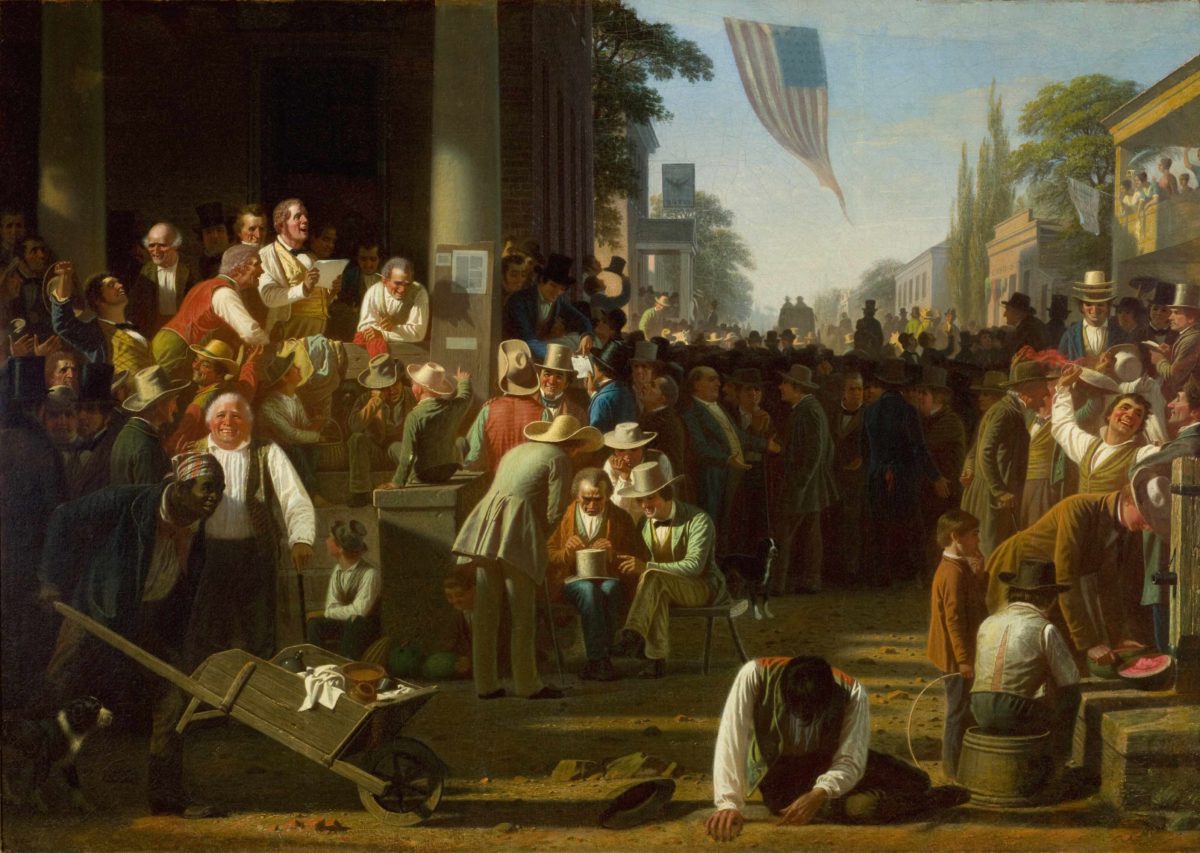
“The past is never dead. It’s not even past,” William Faulkner wrote. It’s fitting, then, that a momentous week that begins with a holiday honoring Martin Luther King, Jr., and culminates with the inauguration of America’s 45th President, should be followed up by a minor but simmering controversy surrounding a 162-year-old painting. Donald J. Trump, meet The Verdict of the People.
Painted by Missourian George Caleb Bingham in 1855, The Verdict of the People—a warts-and-all picture of antebellum democracy in action—is set to be displayed behind Trump’s table at his post-swearing in luncheon. A celebration at which congressional leaders play host to the newly installed president and vice president, the event takes place this Friday at the National Statuary Hall inside the US Capitol. The problem is that the painting depicts a blatantly racist America. I know all about politicians having blind spots, but this is ridiculous.
Furnished by the Saint Louis Art Museum at the request of Senator Roy Blunt from Missouri, the Chairman of the Joint Congressional Committee on Inaugural Ceremonies, the loan of Bingham’s painting has raised the hackles of art lovers around the country. A petition to cancel the loan led by art historian Ivy Cooper and artist Ilene Berman, both St. Louis-area residents, has gathered nearly 5,000 signatures by January 18. The two criticize “the use of the painting to suggest that Trump’s election was truly the ‘verdict of the people,’ when in fact the majority of votes …were cast for Trump’s opponent.”
George Caleb Bingham, Self Portrait (1834-35). Courtesy of the Saint Louis Art Museum, Eliza McMillan Trust.
The Saint Louis Art Museum, for its part, has stood firm behind its decision to lend the picture, as well as their institutional credibility, to the incoming president—or, at least, to the formal trappings of the office. Besides saying that the museum considers it an “honor” to “be part of the inauguration,” the institution’s director, Brent Benjamin, has given the petition’s signatories what a savvy journalist—or, alternately, a broad-minded ethicist—might call the nonpartisan brush off.
“The museum takes no position on candidates for public office,” Benjamin wrote in an official statement. The ironclad position of this museum’s decider-in-chief makes this critic wonder if Benjamin would have also offered important museum artworks to other openly bigoted politicians—Senators Strom Thurmond and Jesse Helms, for instance, or disgraced Illinois governor Rod Blagojevich.
Leaving aside the matter of the loan, it’s clear that few of the parties involved in the controversy have done more than glance at Bingham’s remarkably straightforward painting. Though Senator Blunt describes Bingham’s depiction of a lily-white crowd taking in the aftermath of a municipal election as “inclusive” and populated by a cross-section of America—the luncheon press release mentions “farmers, laborers, merchants, westerners, kids, politicians, immigrants, veterans, women, and African-Americans”—nothing could be further from the fact-based truth.
George Caleb Bingham, Stump Speaking (1853–54). Courtesy of the Saint Louis Art Museum, Gift of Bank of America.
Far from favoring the country’s modern-day melting pot, Bingham’s depiction instead presents an oil-on-canvas view of America as a country that is white-ruled, slave owning, misogynist, and politically unstable. A notably boorish celebration of an electoral rout—complete with good ole boys with whisky sunburns—that historians say depicts a Missouri town’s reaction to a proslavery candidate’s election victory, Bingham’s The Verdict of the People serves both as a lesson in American civics (the election was conducted peacefully) but also as a warning. Peel back the planter’s hats, flouncy shirts and bowties, and the painting resembles a modern-day KKK rally—or at the very least the preamble to Nate Parker’s Birth of a Nation.
As Philip Kennicott pointed out in the Washington Post, Bingham’s The Verdict of the People was painted just as Congress passed the racist Kansas-Nebraska Act of 1854, which put slavery in the territory to a popular vote. It was the final image in a three-part “Election Series” the artist made in response to the nation’s lurch towards Civil War (the other paintings are The County Election and Stump Speaking). But Bingham was not merely anti-slavery; after a spell in the Missouri state legislature, he rightly anticipated the conflagration that would result from slavery’s expansion. When the offending act passed both legislative chambers, Bingham penned a line that now appears monumental: “The deed is done, and a storm is now brewing.”
Contained within the frame of Bingham’s now infamous picture is the depiction of a throng of white men that overflows a public square as the results of a popular ballot are announced. The large majority of them are smiling, and no wonder. The world is their plantation, as Bingham makes clear by placing a group of women on a balcony in the background and a lone black man pushing a wheelbarrow in the foreground (he’s selling hooch). Whether inadvertently or not, The Verdict of the People provides a snapshot of America before its greatest crisis: racism and sexism were common even among anti-slavery advocates like Bingham, and only white men were allowed to vote.
The fact that Trump supporters have mistaken a politically charged representation of one of the darkest moments in American history for an upright image of how to “Make America Great Again” doesn’t just boggle the mind—it places it on high alert. Down is up, and up is down in this new reality. Senator John Lewis—a civil rights hero—is a liar, and Donald Trump won the presidential election in a landslide. That, we are brazenly told, is The Verdict of the People.